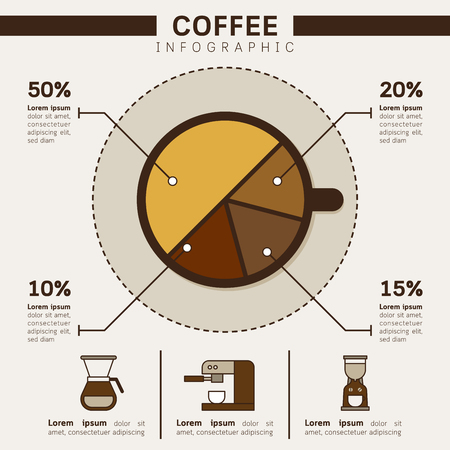Introduction to Sustainability in the Coffee Industry
Coffee shops have become a staple of American culture, serving as social hubs and daily pit stops for millions. However, beneath the inviting aroma of freshly brewed coffee lies a set of sustainability challenges that are increasingly difficult to ignore. From single-use cups piling up in landfills to energy-intensive brewing equipment and the global impact of coffee bean sourcing, U.S. coffee shops face mounting pressure to adopt more sustainable operations. Today’s consumers are not only seeking their caffeine fix; they are also demanding that their favorite cafés take meaningful steps toward environmental responsibility. This growing eco-consciousness is shaping both how coffee shops operate and how they present their brand identities. As climate change and resource scarcity remain pressing global issues, integrating eco-friendly practices has shifted from being a niche trend to an essential part of running a successful coffee business in America.
Sourcing Ethical and Sustainable Coffee
One of the foundational steps for coffee shops aiming to operate sustainably is to prioritize ethical and sustainable sourcing practices. The journey from farm to cup is complex, and each decision along the supply chain has significant environmental and social implications. By adopting transparent sourcing strategies, coffee shops can support both people and the planet while enhancing their brand reputation among eco-conscious consumers.
Direct Trade: Building Stronger Relationships
Direct trade refers to a sourcing model where coffee shops establish direct relationships with coffee farmers or cooperatives. This approach allows for greater transparency, ensures higher prices for farmers, and encourages environmentally friendly farming practices. Through direct trade, coffee shops can gain firsthand knowledge of how their coffee is grown, processed, and transported, fostering long-term partnerships based on trust and shared values.
Fair Trade Certifications: Ensuring Social Responsibility
Fair trade certification is another prominent method for responsible sourcing. These certifications guarantee that farmers receive a minimum price for their beans, promote safe working conditions, prohibit child labor, and encourage sustainable agricultural practices. For American consumers who value ethical consumption, fair trade labels are a recognizable symbol of a coffee shop’s commitment to global social justice and environmental stewardship.
Comparison of Sourcing Models
| Sourcing Model | Main Benefits | Potential Challenges |
|---|---|---|
| Direct Trade | Strong relationships, quality control, higher farmer income | Requires more resources for relationship management and travel |
| Fair Trade Certification | Verified ethical standards, consumer trust, community development | Certification fees, limited flexibility in sourcing options |
| Conventional Sourcing | Ease of procurement, lower costs | Lack of transparency, potential exploitation of farmers, unsustainable practices |
The Importance of Supporting Coffee Farmers Responsibly
Sustainable sourcing isn’t just about the environment—it’s also about supporting the livelihoods of coffee producers around the world. Ethical sourcing empowers farmers by providing fair compensation and encouraging the use of eco-friendly farming methods such as shade-grown cultivation and organic fertilization. This holistic approach leads to healthier ecosystems, stronger communities, and better-quality coffee beans for American coffee lovers.
Key Takeaway for U.S. Coffee Shops
By integrating direct trade or fair trade-certified beans into their operations, American coffee shops can set themselves apart as leaders in sustainability. Responsible sourcing not only benefits farmers and the environment but also resonates with today’s socially conscious customers—ultimately building a loyal customer base that shares these core values.

3. Reducing Waste and Promoting Reusables
For coffee shops in the U.S., adopting sustainable practices goes far beyond sourcing eco-friendly beans—it’s about transforming daily operations to minimize environmental impact. One of the most pressing challenges is reducing reliance on single-use plastics, which are a major contributor to landfill waste and ocean pollution. Many forward-thinking cafés are swapping out plastic straws, stirrers, and lids for compostable or biodegradable alternatives made from materials like cornstarch or bamboo. Additionally, switching to paper or reusable metal straws and offering plant-based cups can dramatically lower a shop’s ecological footprint.
Strategies for Minimizing Single-Use Plastics
Effective waste reduction begins with a critical look at packaging and service items. Coffee shops are increasingly providing incentives—such as discounts or loyalty points—for customers who bring their own reusable mugs or tumblers. Some businesses even sell branded, durable drinkware to foster a culture of reuse and extend brand visibility outside the store. Clear signage and staff training help reinforce these practices, making it easy for customers to make greener choices without sacrificing convenience.
Implementing Composting and Recycling Programs
Beyond reducing plastics, implementing robust composting and recycling programs is essential for sustainable operations. Many American cities offer commercial composting services that coffee shops can use for food scraps, coffee grounds, and compostable packaging. Partnering with local waste management companies ensures that recyclable materials—like cardboard sleeves and glass bottles—are diverted from landfills. Training employees on proper sorting techniques is crucial for maximizing the effectiveness of these programs.
Encouraging Customers to Use Reusable Cups
Coffee shops play an influential role in shaping customer behavior. By normalizing reusable cup usage through engaging social media campaigns, in-store prompts, and educational events, businesses can create lasting change within their communities. Some shops go further by participating in “cup swap” networks or offering rental cup programs for on-the-go patrons. Not only do these initiatives reduce waste, but they also position the brand as an innovator in sustainability—a key differentiator in today’s environmentally conscious marketplace.
Conclusion: Building a Culture of Sustainability
Ultimately, reducing waste in coffee shops isn’t just about policy—it’s about building a culture where both staff and customers are invested in sustainable living. By minimizing single-use plastics, embracing composting and recycling, and promoting reusables, coffee shops can significantly lower their environmental impact while strengthening their brand as responsible community leaders.
4. Energy and Water Conservation
Adopting energy and water conservation measures is a crucial aspect of sustainable coffee shop operations in the United States. Not only does this approach align with eco-friendly values, but it also reduces long-term operating costs and strengthens brand reputation among environmentally conscious consumers.
Implementing Energy-Efficient Equipment
Coffee shops can significantly lower their carbon footprint by investing in energy-efficient appliances such as LED lighting, ENERGY STAR-certified espresso machines, and smart thermostats. These upgrades not only minimize energy consumption but also ensure consistent quality and performance in daily operations.
Energy-Efficient Equipment Comparison
| Equipment Type | Traditional Model | Energy-Efficient Model |
|---|---|---|
| Espresso Machine | High Power Usage | Reduces Energy by 30% |
| Lighting | Incandescent Bulbs | LED (Uses 75% Less Energy) |
| Refrigeration | Standard Fridge | ENERGY STAR Certified (Saves 10-15%) |
Reducing Water Waste
Water conservation is equally important for sustainable coffee shop operations. Simple strategies—such as installing low-flow faucets, using efficient dishwashers, and regularly checking for leaks—can make a substantial difference. Baristas can be trained to use only the necessary amount of water during cleaning and beverage preparation, further reducing waste.
Water Conservation Strategies Overview
| Strategy | Description | Estimated Savings |
|---|---|---|
| Low-Flow Fixtures | Reduces water per use in sinks/toilets | Saves up to 30% |
| Efficient Dishwashers | Cleans more with less water per cycle | Saves up to 50 gallons/day |
| Leak Detection & Repair | Avoids unnoticed water loss | Saves hundreds of gallons/year |
Utilizing Renewable Resources in Operations
Coffee shops can take sustainability one step further by sourcing renewable energy, such as solar or wind power, to run daily operations. Many American cities offer incentives for businesses that switch to green electricity providers. Additionally, implementing rainwater harvesting systems for non-potable uses like landscaping or cleaning supports resource conservation while showcasing a commitment to environmental stewardship.
The Bottom Line for Coffee Shops: Efficiency is Good Business
Pursuing energy and water conservation not only preserves vital resources but also appeals to customers who value responsible business practices. By making these changes visible through branding and customer education, coffee shops can strengthen their market position while contributing positively to their communities and the planet.
5. Eco-Friendly Branding and Community Engagement
Eco-friendly branding is more than just a buzzword—its a crucial strategy for coffee shops aiming to stand out in Americas competitive marketplace while appealing to a rapidly growing demographic of environmentally conscious consumers. To effectively communicate their green initiatives, coffee shops should prioritize transparency and authenticity in every aspect of their brand messaging. This means going beyond generic claims and providing tangible proof of sustainable practices, such as sourcing coffee beans from certified organic farms, using compostable packaging, or implementing energy-saving technologies.
Storytelling and Visual Identity
Coffee shops can leverage storytelling by sharing the journey of their sustainability efforts through in-store signage, social media campaigns, and dedicated sections on their websites. Highlighting stories about local farmers, waste reduction milestones, or partnerships with environmental organizations helps humanize the brand and builds trust with customers. Consistent visual cues—like green color palettes, eco-certification logos, or upcycled décor—reinforce the shops commitment to sustainability at every customer touchpoint.
Transparent Communication Channels
Maintaining open communication channels is key. Encourage feedback through comment cards or online reviews specifically about green initiatives. Hosting Q&A sessions or sustainability workshops can also foster community dialogue and demonstrate that the shop values customer input while remaining accountable for its environmental promises.
Community Involvement and Local Partnerships
To authentically connect with eco-minded consumers, coffee shops should engage directly with their local communities. Participating in neighborhood clean-ups, supporting local environmental nonprofits, or offering discounts for reusable cup usage are practical ways to show commitment beyond marketing slogans. Collaborations with like-minded local businesses further strengthen credibility and expand the reach of sustainable practices within the community.
Ultimately, a holistic approach that blends genuine eco-friendly operations with transparent communication and active community engagement allows coffee shops to build lasting relationships with environmentally aware customers, positioning themselves as true leaders in sustainability within the American coffee culture.
6. Challenges and Opportunities in Going Green
Adopting sustainable practices in coffee shops is not without its hurdles, but these challenges also bring forth unique opportunities for innovation and growth. One of the most common obstacles is the higher upfront cost associated with eco-friendly equipment, organic ingredients, and sustainable packaging. For independent coffee shop owners, these expenses can be daunting compared to conventional alternatives. Additionally, sourcing local or fair-trade coffee beans often requires building new supplier relationships, which may involve logistics complexities and unpredictable pricing. Another challenge lies in customer education—some patrons may resist changes like reusable cup policies or compostable straws if they are not familiar with the environmental benefits.
Despite these barriers, there are numerous innovative solutions tailored specifically to the coffee shop industry. Many shops have found success by partnering with local roasters and suppliers committed to sustainability, thus reducing transportation emissions and supporting their community’s economy. Adopting a phased approach to eco-friendly upgrades—such as gradually replacing single-use plastics with biodegradable options—can make the transition more manageable financially. Technology also plays a role: digital loyalty programs encourage customers to bring their own cups, while smart inventory systems help minimize waste by accurately forecasting demand.
Beyond operational changes, going green offers branding opportunities that resonate with American consumers’ growing preference for environmentally responsible businesses. Transparent communication about sustainability initiatives—through signage, social media, or staff training—builds trust and loyalty among eco-conscious patrons. Coffee shops can host educational events or collaborate with environmental organizations to further engage their community and strengthen their brand identity.
Ultimately, while the path to sustainability presents real-world challenges, it also drives creativity and positions coffee shops as leaders in the green movement. By embracing both short-term solutions and long-term strategies, the industry can overcome barriers and thrive in a market where ethical choices matter more than ever.


